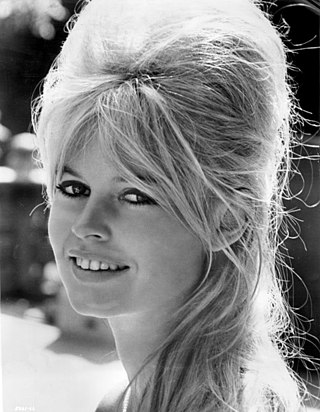
Brigitte Anne-Marie Bardot, often referred to by her initials B.B., is a French animal rights activist and former actress, singer, and model. Famous for portraying sexually emancipated characters, often with hedonistic lifestyles, she was one of the best known activists in the sexual revolution of the 1950s–1970s. Although she withdrew from the entertainment industry in 1973, she remains a major popular culture icon and a noted figure in ushering in the sexual revolution. She has acted in 47 films, performed in several musicals, and recorded more than 60 songs. She was awarded the Legion of Honour in 1985.

George Orson Welles was an American director, actor, writer, producer, and magician who is remembered for his innovative work in film, radio, and theatre. He is considered to be among the greatest and most influential filmmakers of all time.

Peter Bogdanovich was an American director, writer, actor, producer, critic, and film historian. He started his career as a film critic for Film Culture and Esquire before becoming a prominent filmmaker as part of the New Hollywood movement. He received accolades including a BAFTA Award and Grammy Award, as well as nominations for two Academy Awards and two Golden Globe Awards.

The Little Prince is a novella written and illustrated by French writer, and military pilot, Antoine de Saint-Exupéry. It was first published in English and French in the United States by Reynal & Hitchcock in April 1943 and was published posthumously in France following liberation; Saint-Exupéry's works had been banned by the Vichy Regime. The story follows a young prince who visits various planets, including Earth, and addresses themes of loneliness, friendship, love, and loss. Despite its style as a children's book, The Little Prince makes observations about life, adults, and human nature.

Touch of Evil is a 1958 American film noir written and directed by Orson Welles, who also stars in the film. The screenplay was loosely based on the contemporary Whit Masterson novel Badge of Evil (1956). The cast included Charlton Heston, Janet Leigh, Joseph Calleia, Akim Tamiroff and Marlene Dietrich.

Roger Vadim Plemiannikov was a French screenwriter, film director and producer, as well as an author, artist and occasional actor. His best-known works are visually lavish films with erotic qualities, such as And God Created Woman (1956), Blood and Roses (1960), Barbarella (1968), and Pretty Maids All in a Row (1971).
Ingeborg Hermine Morath was an Austrian photographer. In 1953, she joined the Magnum Photos Agency, founded by top photographers in Paris, and became a full photographer with the agency in 1955. Morath was the third wife of Pulitzer Prize-winning playwright Arthur Miller; their daughter is screenwriter/director Rebecca Miller.

The French Riviera, known in French as the Côte d'Azur, is the Mediterranean coastline of the southeast corner of France. There is no official boundary, but it is considered to be the coastal area of the Alpes-Maritimes department, extending from the rock formation Massif de l'Esterel to Menton, at the France–Italy border, although some other sources place the western boundary further west around Saint-Tropez or even Toulon. The coast is entirely within the Alpes-Maritimes, a department within Provence-Alpes-Côte d'Azur region of France. The Principality of Monaco is a semi-enclave within the region, surrounded on three sides by France and fronting the Mediterranean. The French Riviera contains the seaside resorts of Cap-d'Ail, Beaulieu-sur-Mer, Saint-Jean-Cap-Ferrat, Villefranche-sur-Mer, Antibes, Juan-les-Pins, Cannes, and Theoule-sur-Mer.

Rita Hayworth was an American actress, dancer, and pin-up girl. She achieved fame in the 1940s as one of the top stars of the Golden Age of Hollywood, and appeared in 61 films in total over 37 years. The press coined the term "The Love Goddess" to describe Hayworth, after she had become the most glamorous screen idol of the 1940s. She was the top pin-up girl for GIs during World War II.
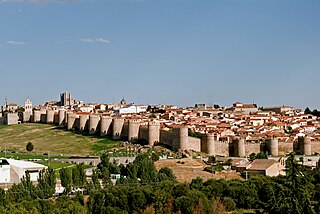
Ávila is a city of Spain located in the autonomous community of Castile and León. It is the capital and most populated municipality of the Province of Ávila.

Ciboure is a commune in the Pyrénées-Atlantiques department in south-western France.

Saint-Tropez is a commune in the Var department and the region of Provence-Alpes-Côte d'Azur, Southern France. It is 68 kilometres west of Nice and 100 kilometres east of Marseille, on the French Riviera, of which it is one of the best-known towns. In 2018, Saint-Tropez had a population of 4,103. The adjacent narrow body of water is the Gulf of Saint-Tropez, stretching to Sainte-Maxime to the north under the Massif des Maures.

Rebecca is a 1938 Gothic novel written by English author Daphne du Maurier. The novel depicts an unnamed young woman who impetuously marries a wealthy widower, before discovering that both he and his household are haunted by the memory of his late first wife, Rebecca.
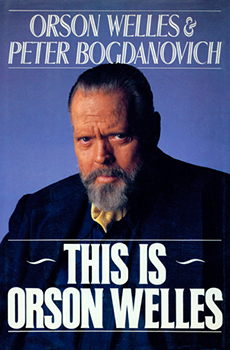
This is Orson Welles is a 1992 book by Orson Welles and Peter Bogdanovich that comprises conversations between the two filmmakers recorded over several years, beginning in 1969. The wide-ranging volume encompasses Welles's life and his own stage, radio, and film work as well as his insights on the work of others. The book was edited after Welles's death, at the request of Welles's longtime companion and professional collaborator, Oja Kodar. Jonathan Rosenbaum drew from several incomplete drafts of the manuscript and many reel-to-reel tapes, most of which had already been transcribed. Much of the dialogue, however, had been rewritten by Welles, often in several drafts.
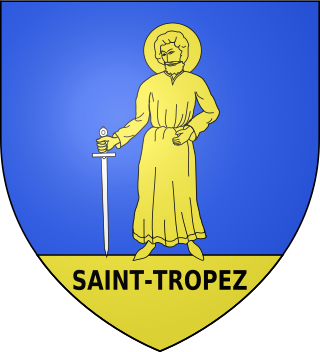
Torpes of Pisa is venerated as an early Christian martyr. The town of Saint-Tropez, France, is named after him. His legend states that he was martyred during the persecutions of Nero. Most of the accounts about him are considered unreliable. Nothing else is known about his life. He is first mentioned in sources dating from the 9th century.
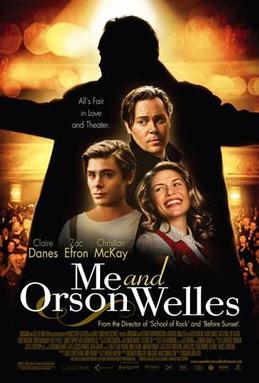
Me and Orson Welles is a 2008 period drama film directed by Richard Linklater and starring Zac Efron, Christian McKay, and Claire Danes. Based on Robert Kaplow's novel of the same name, the story, set in 1937 New York, tells of a teenager hired to perform in Orson Welles's groundbreaking stage adaptation of William Shakespeare's Julius Caesar who becomes attracted to a career-driven production assistant.
Don Quixote is an unfinished film project written, co-produced and directed by Orson Welles. Principal photography took place between 1957 and 1969. Test footage was filmed as early as 1955, second-unit photography was done as late as 1972, and Welles was working on the film intermittently until his death in 1985. The film was eventually edited by Jesús Franco and was released in 1992, to mixed reviews.
This is a bibliography of books by or about the director and actor Orson Welles.
Twelfth Night is a 1933 American Pre-Code short color film, notable as the very earliest surviving film directed by Orson Welles, then aged 17. It is a recording of the dress rehearsal of Welles's own abridged production at his alma mater, the Todd School for Boys, where he had returned to direct this adaptation of Shakespeare's Twelfth Night for the Chicago Drama Festival in 1933. The play won first prize at that year's festival, presented as part of the 1933 Chicago World's Fair, A Century of Progress Exposition.
Beatrice Giuditta Welles is an American former child actress, known for her roles in the film Chimes at Midnight (1966) and the documentary travelogue In the Land of Don Quixote (1964). The daughter of American filmmaker Orson Welles and Italian actress Paola Mori, she is a former model, radio and TV personality, founder of a cosmetics line and designer of handbags and jewelry.














